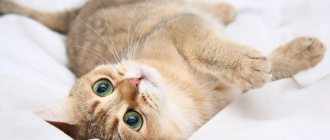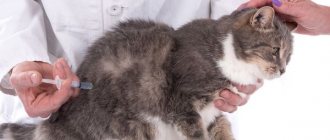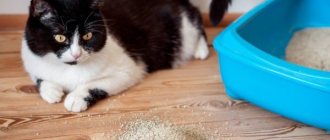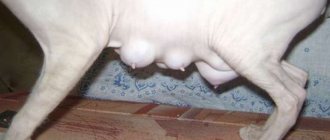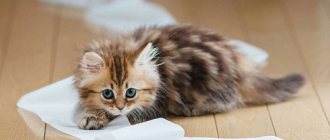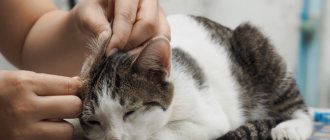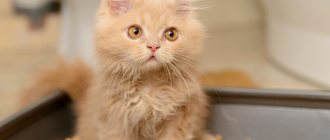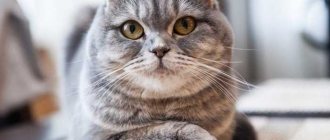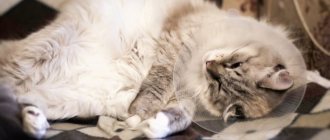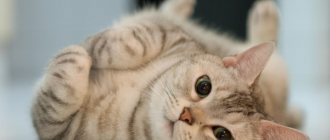A laxative for cats helps relax the intestinal walls, while maintaining their tone and without disturbing the microflora. Every cat owner should have laxatives in their first aid kit. Problems with defecation as a result of malfunctions of the digestive tract can cause intoxication of the entire body, poisoning the pet with toxins. In severe cases, even death is possible, which is why the symptoms of constipation and digestive tract disorders should be recognized in time in order to eliminate the problem in time.
Problems with defecation are solved with drug therapy, home remedies, and also with the help of traditional medicine recipes.
When does a cat need a laxative?
Cats should be given a laxative only after the cause of their difficulty in defecation has been determined. Constipation can be caused by poor nutrition, stress, moving, or fear. Cats sometimes experience constipation caused by emotional and psychological factors. For example, constipation may occur due to rejection of the tray, filler, new house, or simply due to the appearance of a new pet in the house.
It is necessary to find out the specific reason, try to create comfortable conditions for the pet to go to the toilet, change the litter, use anti-stress sedatives prescribed by the veterinarian. Constipation, which is caused by a change in food, the introduction of a new product into the diet, or a transition to a different type of food, begins to be treated with the use of a special diet or switching to dietary nutrition.
Constipation can also occur with:
- eating diet foods with low protein content;
- the presence of a tumor in the digestive tract;
- dehydration of the body;
- inflammatory processes in the rectum;
- orthopedic problems, when the pet finds it difficult to sit down and defecate comfortably;
- sedentary lifestyle;
- presence of megacolon disease;
- renal failure;
- helminthiasis;
- the presence of hairballs in the stomach;
- the presence of growths, inflammation on the body.
Constipation in a cat is detected by the absence of defecation for more than 2-3 days. At the same time, the cat meows, makes unsuccessful attempts to sit in the tray or simply in a hidden corner, wanting to free itself from uncomfortable feelings.
The cat may constantly visit the toilet and defecate with great difficulty. The feces have the form of dense nuts or a watery appearance. These symptoms indicate the presence of chronic constipation.
Both acute and chronic constipation is accompanied by weakness, lack of appetite in the animal, nausea and vomiting (rarely). A cat may refuse to eat and lose weight, some stop licking themselves, and their nose is completely dry.
Laxatives for cats should only be used after consultation with a veterinarian. Constipation can be confused with intestinal obstruction, and this pathology must be treated in a different way, using other medications.
The drugs are mainly used for cats after sterilization/castration, or when the animal has not had bowel movements for more than three days.
Laxatives should not be used if constipation is caused by swallowing hard objects or bones, or if there are traces of mucus or blood in the stool.
Symptoms of constipation
Normally, a domestic cat defecates daily, usually at about the same time. However, some animals have bowel movements less frequently; this varies from person to person. Loving and caring owners always pay attention to the condition of the cat's litter box in order to promptly clean up after their pet.
If the second day has passed and there is no bowel movement, this is a reason to watch the cat.
In cases where the intestines do not empty, the feces lose water, become hard, and cause significant discomfort to the animal. In addition, excrement is something that the body does not need, it eliminates it, and if bowel movements do not occur, toxins from stagnant feces begin to spread throughout the body.
Constipation can be recognized by the following symptoms:
- the tray is clean for more than two days;
- a cat can dig around for a long time, sit down in the tray, sit for a long time, but without results;
- it is noticeable that the animal is tense, straining, and sometimes makes plaintive sounds;
- The cat sometimes does not go to the litter box, tries to sit somewhere in the corner, but does not leave excrement.
Sometimes, if the cause of constipation is a pathological process, the cat may have additional symptoms. The animal may vomit and vomit; it meows pitifully, trying to communicate unpleasant symptoms and pain. The cat becomes lethargic and inactive. The temperature may rise, the stomach becomes tense, and it is impossible to touch it (cats, even under normal conditions, do not really like touching the stomach, but when sick they can react aggressively to attempts to touch it).
A small amount of stool containing blood or mucus may appear. Sometimes only mucus or blood comes out of the anus. This is a serious symptom that requires immediate contact with a veterinarian.
How do laxatives work?
Laxatives for cats are divided into several groups. The effects of these medications differ from each other.
The main action of laxatives for cats is aimed at:
- stimulation of peristalsis of the large intestine by mechanical or chemical irritation of the nerve endings located on its surface. This group includes medicines containing isophenine or phenolphthalein, as well as natural medicines based on buckthorn bark, hay, and rhubarb.
- softening stool and making it easier to slide. This group of laxatives includes vegetable oils (olive, vaseline, flaxseed, sunflower, castor).
- slowing down the process of reabsorption of water through the walls of the colon, which contributes to the dilution of feces and its easy removal. Such agents with a laxative effect include sorbitol, xylitol, agar-agar, and magnesium.
All laxative drugs are used for symptomatic treatment and have a temporary effect. Their action is aimed at reducing the severity of symptoms and eliminating unpleasant signs. For complete treatment, it is necessary to identify the cause of constipation through an examination, which may include blood tests, stool tests and an ultrasound of the pet’s abdominal organs.
Side effects, symptoms of overdose and their elimination
After administering this drug to an animal, it may experience the following symptoms:
- diarrhea (liquid stool may have a foamy consistency);
- attacks of nausea and vomiting;
- excessive formation of gases in the intestines;
- petrification of the abdomen;
- signs of dehydration of the body;
- weakness, lethargy, loss of interest in food;
- muscle cramps;
- increased or slowed heart rate.
Are the items in a person’s first aid kit suitable?
Not all products in a human medicine cabinet are suitable for cats. Some of them can cause intoxication and even death in pets. It is very difficult to correlate the dose intended for humans with the average weight of a cat (3-5 kg).
It is safer when the drug is chosen by a veterinarian. Drug treatment should be used only after examination by a specialist and only with the use of approved drugs in the dose prescribed by the doctor.
When do you need veterinary help?
You cannot do it on your own if any alarming symptoms appear that affect your pet’s usual state. A plaintive meow is a signal for help. Listen to your mustachioed pet and try to put off all other things until you find out the cause of the problem.
After abdominal surgery, carefully monitor the timing. Delayed bowel movements in the first days are explained by refusal to feed and weak peristalsis inhibited by anesthesia. If the condition does not return to normal within 2 days, contact your doctor. The cause of the delay may be damage to the walls of the rectum. In this case, repeat surgery will be required.
Medicines
Based on their composition and type of effect on the animal’s body, laxatives are divided into the following groups:
- bulk-forming laxatives;
- osmotic laxatives;
- lubricants;
- laxatives with a stimulating effect;
- enemas.
- Bulk-forming drugs include medications that pass through the gastrointestinal tract in an undigested state. They begin to expand in the colon by absorbing water, which helps soften the stool and increase its weight. The period of action of these funds ranges from 12 to 72 hours. Taking drugs in this group should be accompanied by plenty of fluids. Drugs in this group are prescribed for chronic constipation or for their prevention, irritable bowel syndrome, hemorrhoids, anal fissure, and during pregnancy.
The recommended drugs in this group are Metamucil and drugs based on flax seeds.
- Osmotic laxatives help draw fluid from the cat's body into the large intestine, and therefore it is necessary to provide cats with plenty of fluids while taking these drugs. Fecal masses increase with the help of fluid and begin to put pressure on the intestinal walls, causing the urge to have a bowel movement.
These products contain lactulose, which acts at the level of the colon. Lactulose suppresses the growth of pathogenic intestinal microflora. The laxative effect occurs after 24-48 hours. These drugs are prescribed for acute and chronic constipation, dysbacteriosis, and after surgery (sterilization or castration).
Recommended medications are Lactusan, available in the form of syrup or tablets, and Duphalac. Duphalac can be given to cats in the form of syrup or powder. The dose is 0.5 ml per 1 kg of cat weight, 3 times a day.
- Lubricants or malt pastes are used to combat hairballs. They lubricate the intestinal walls, helping remove hairballs from the body. The composition of lubricants includes vitamins A, E, D. These preparations include TRIXIE Malt'n' Grass, Beaphar Mailt Paste.
This group of laxatives includes petroleum jelly and products based on it. Vaseline oil coats the intestinal walls, helping to remove foreign bodies, hard stones and bezoars. The substance is considered safe and mild. It is not absorbed, does not accumulate in the body, and does not cause allergies. Vaseline oil, getting inside, creates a slippery film on the walls of the intestines, which allows you to naturally remove accumulated feces. In addition, petroleum jelly protects the body from toxins, preventing them from being absorbed, which helps prevent intoxication of the cat’s body.
Recommended drugs are Bimin, vaseline oil.
The laxative effect occurs after 3-6 hours. Dose – 1 ml of oil per 1 kg of pet’s weight. This group of drugs is used for episodic constipation, after surgery (sterilization, castration, abdominal surgery), in the postpartum period, and for coprostasis.
- Stool softeners reduce the surface tension of your cat's stool, allowing it to more actively absorb water. The mechanism of action of the drugs is determined by the salts they contain. These medications should be used very carefully, only as prescribed by a doctor. The effect of the drugs occurs after 3-6 hours.
This group of drugs is prescribed for intoxication, occasional chronic constipation, and for cleansing the intestines before abdominal surgery or sterilization.
Docusate sodium is prescribed, which is a fast-acting remedy. The dose is determined by the doctor strictly on an individual basis.
- Laxatives with a stimulating effect act by irritating the muscles of the colon, activating its functionality. The drugs improve the structure of feces, facilitating the act of defecation. The effect occurs after 6-10 hours; it is prescribed for acute constipation.
The recommended medication is Bisacodyl.
- An enema helps empty the intestines of stagnant feces. You need to do an enema with warm boiled water or chamomile infusion. The procedure must be performed by a doctor in a clinical setting.
general description
Duphalac is produced in the form of syrup. The formula of the drug is developed based on the use of lactulose, which is a synthetic polysaccharide of fructose. In addition to lactulose, the composition also includes purified water. The drug does not contain:
- preservatives;
- dyes;
- flavorings;
- other chemicals.
Therefore, Duphalac is considered safe for both small children and cats, whose bodies are also vulnerable to various factors.
To package the syrup, polymer bottles with a screw cap with a capacity of 200, 500 and 1000 ml are used. The medicine is also packaged in 15 ml foil bags. 10 of these bags are placed in a cardboard package. The second packaging option is more preferable for cats, although the purchased medicine can be used for animals and all household members.
The medicine does not require special storage. It is enough to place it in a dark and dry place, inaccessible to sunlight. In this case, the air temperature should be between 10 and 25 degrees Celsius. A home or veterinary first aid kit is suitable for storage.
Home Remedies
Sometimes the use of laxatives in cats is not advisable. You can replace medications with products prepared from traditional recipes. Laxatives can be prepared at home using decoctions of medicinal herbs, raw vegetables, vegetable oils, and condensed milk. Massaging your pet's belly is also an effective way.
You should get your veterinarian's approval before using homemade laxatives. It is important to begin treatment after the cause of the pathological condition is identified.
- Vegetable oil can be added to your cat’s low-fat food, normally 1-2 drops. The method can only be used for adult cats and male cats no more than once a month. Kittens are not allowed to give vegetable oil. Overdose in order to obtain a quick effect is not allowed. Large amounts of oil negatively affect the liver of cats.
- Condensed milk helps normalize intestinal function in cats and soften feces. The laxative effect of condensed milk will be ensured if you give your cat a drink made from a mixture of condensed milk and raw tap water (1:1). The drink can be given to your pet no more than once a day, as the liquid can cause diarrhea.
- Raw vegetables are one of the effective homemade laxatives. This is a useful and effective way to treat constipation in cats. Vegetables should be fresh and juicy. It is best to use them in the form of freshly squeezed juice, which is poured into the cat's mouth using a syringe or pipette. Every day, a pet with problems with bowel movements should be given about 30 ml of juice. You can also add a small piece of grated vegetable weighing 30g to your cat’s food. It is recommended to use beets, carrots, and cauliflower.
- with cleansing enemas . But if the need arises, you can carry out the procedure at home. In this case, the cat should be fixed on the table and a tray should be placed next to it for emptying. The tip of the enema should be smeared with Vaseline, and then the air should be released from it. A ready-made chamomile decoction or warm water in an amount of 50 ml (pre-boiled) should be taken into an enema and inserted into the cat’s anus.
Within a few minutes the cat will empty its stomach. After the procedure, it is recommended to use suppositories to relieve inflammation.
- Abdominal massage should be carried out comprehensively. The cat needs to be given a laxative, then begin to massage the fluffy’s tummy with light clockwise movements. It is recommended to carry out the procedure 3-4 times a day.
- Herbal medicine is one of the proven ways to eliminate constipation in cats. The cat should be given laxative decoctions of aloe, celandine, chamomile, mint, lemon balm, and rhubarb leaves.
When is a laxative necessary?
Having identified symptoms of constipation in a cat, you should not immediately give it laxatives, be it traditional or medicinal. Sometimes this is absolutely not worth doing.
Sometimes the absence of bowel movements is explained by psychological problems or stress. In such cases, laxatives are not needed. The animal must be calmed and a comfortable environment created.
In difficult cases, your pet should be examined by a veterinarian and undergo a course of treatment with antidepressants.
The cat may not accept the tray, the place where it is, or may not tolerate the filler for some reason. In such cases, the reason for the lack of defecation is also in a stressful state, and the animal needs help: change the type of litter, rearrange the tray, sometimes even buy another toilet.
If the cause of constipation is nutritional problems (prolonged fasting, switching to another food, inappropriate food), then the pet needs a diet.
You should consult your veterinarian on what to feed your cat. In such cases, folk remedies can be used for relief.
Medicines should not be given without a doctor’s prescription, especially if they are intended for humans. In some cases, you can use medications, for example, if the animal has undergone castration or sterilization surgery, the veterinarian will tell you about the appropriate ones.
If the cat does not go to the toilet for more than three days and experiences noticeable discomfort, it can also be helped with medication.
In other cases, if blood or mucous inclusions are found in the pet’s stool, then no medications should be given. There is also no need to give a laxative if constipation is caused by intestinal obstruction due to a foreign body.
In such cases, you can do an enema; this method will help to quickly cleanse the rectum and slightly alleviate the cat’s condition. However, you need to show the animal to a doctor as soon as possible.
Also read the article about what to do if a cat cannot go to the toilet in a big way.
Treatment of constipation in cats with lactulose
Lactulose-based medications are available in the form of syrup, which has a sweetish taste and a very thick consistency. The syrup consists of artificially synthesized milk sugar, which helps saturate fecal matter with liquid and soften it. The main active ingredients of Duphalac and similar medications are galactose and fructose. The composition of lactulose-based medicines also includes organic acids, which decompose naturally, enter the large intestine and are excreted along with feces.
During the fermentation of lactulose, organic acids are formed in the cat's intestines, which stimulate the mucous membranes to additionally synthesize fluid. Polysaccharides and liquid synthesized by the intestinal mucous membranes stimulate more active peristalsis and have a laxative effect.
Lactulose-based medications are strictly contraindicated for cats suffering from water-salt or water-electrolyte balance disorders, as well as those suffering from diabetes. An overdose of a drug containing lactulose can cause dehydration.
Preparations containing lactulose are not allowed to be used in combination with other medications, since organic compounds react actively. When medications containing lactulose are metabolized in the cat's body, ammonia is metabolized, which must be released naturally. If the animal has liver pathologies, delays or other problems may occur in the process of ammonia binding, which will lead to intoxication.
The use of this group of drugs can cause side effects such as diarrhea and dehydration. If a negative reaction occurs, you should stop using the drug and consult a specialist.
Where to buy and how much it costs
Duphalac is an over-the-counter product. It can be bought at any pharmacy. The cost of the drug depends on the packaging:
- 1000 ml - from 970 rub.;
- 500 ml - from 520 rub.;
- 200 ml - from 310 rub.;
- box with 10 bags of 15 ml - from 300 rub.
If the pharmacy suddenly does not have Duphalac, you can choose one of the analogues, which also contains lactulose. The following are suitable for treating feline constipation:
Table: comparison of Duphalac analogues
- the main active ingredient is 55.7 grams of lactulose per 100 ml of the drug;
- excipients: cream syrup;
- lemon acid.
- lactose and fructose intolerance;
- intestinal obstruction.
- the main active ingredient is 55 grams of lactulose per 100 ml of the drug;
- excipients: galactose;
- fructose.
- lactase deficiency;
- intestinal obstruction.
- main substance - 66.5 grams of lactulose per 100 ml of the drug;
- Excipient: purified water.
- lactase deficiency;
- intestinal obstruction.
Photo gallery: funds to replace Duphalac
What to give to cats suffering from diabetes
Preparations containing lactulose (Duphalac, Lactusan) should not be given to cats suffering from diabetes.
For such animals it is recommended to apply:
- Sodium picosulfate . The drug causes strong rhythmic contractions of the muscles of the colon. This remedy is usually prescribed to cats after sterilization, when it is undesirable for the animal to push too hard. The dosage and frequency of taking the medication is determined by the veterinarian.
- Nux Vomica-Homaccord . The medicine is used to eliminate hairballs from the body naturally. The product contains substances that soften and lubricate the furball, as well as vitamins that help strengthen the coat.
- Magnesium sulfate . A single dose for an adult cat is half a packet of powder. It is diluted in water and injected into the pet’s cheek using a syringe without a needle.
For pets with diabetes, you can also use herbal medicine and other homemade laxatives that do not affect metabolic processes.
Laxatives help normalize the cat's digestive process and metabolism. All laxative medications have certain contraindications and should only be used after consultation with a veterinarian.
Reviews of people who treated cats with Duphalac
Julia31
My cat is 18 years old, she couldn’t go to the toilet, she screamed, I felt very sorry for her. The veterinarians wanted to euthanize him, but we did not give permission. Duphalac rescued the poor animal from the other world! After 2 days I came to my senses, and for more than six months now she has been running, eating and going to the toilet normally.
Mary
My cat Duphalac could not drink at all. It is sweet, the animal tried its best to spit it out. And if she didn’t succeed, then 5-7 minutes after swallowing the syrup she began to vomit, so the product still came out without getting into the intestines. Apparently, intolerance to the drug.
SvetulyaA
kate427
Duphalac is a laxative that can be used to treat cat constipation. The convenient liquid form allows you to measure the required dosage and easily administer the medicine to the animal (oral administration through the mouth is more convenient than administering injections, enemas or suppositories). The remedy works immediately - in most cases, the cat begins to go to the toilet within 3-4 hours after taking the medicine.
Duphalac for cats is used in case of problems with the gastrointestinal tract. Initially, the medicine was intended for people. It is gentle and safe, which is why veterinarians prescribe it to animals. However, it is important to calculate the dosage correctly. Otherwise, you can harm your pet. Before using the drug, it is necessary to study its mechanism of action and instructions. There are contraindications to the use of the medicine, they also need to be taken into account.
